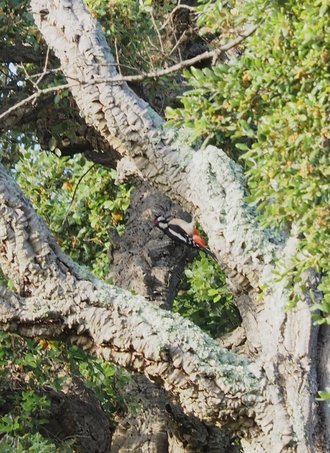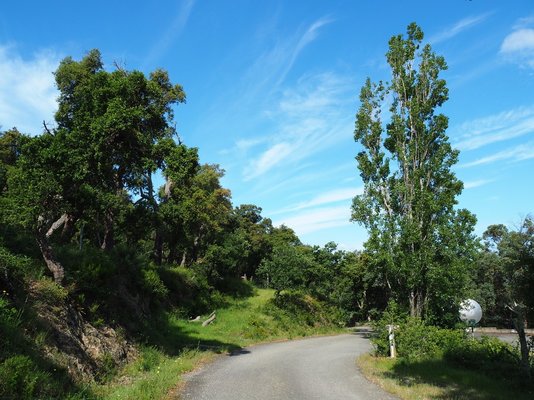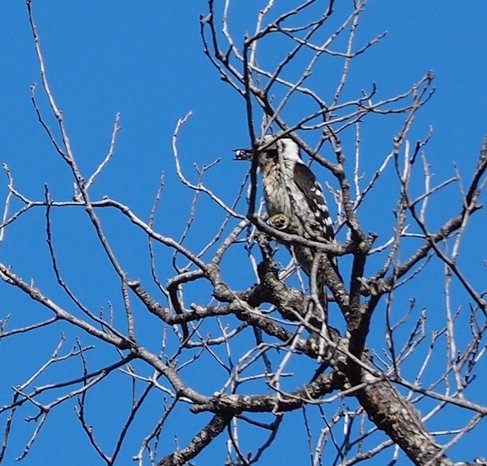This memory resurfaced yesterday when, on a regular walk, a bird caught my attention as it landed in a dead cork oak not far away, just beside the lane. As is so often Sod's Law, I had left the binoculars at home. And am still trying to get used to my new varifocal specs. In profile against the trunk (and against the light), the bird was definitely a woodpecker. My immediate thought was Wryneck because I was close, it was small and surely much too small for a Great Spotted. It looked pale, drab, and after pecking at the bark for a few seconds, it flew away. To my surprise another immediately alighted in exactly the same spot, and pecked briefly at the same bit of tree before flying off as well. This time I thought I caught a flash of black and white spots as it flew. Or did I? From the direction they flew in, I then heard a woodpecker call. Not a Wryneck, but vaguely similar: quick-fire, strident tchik-tchik-tchik-tchik-tchik... Had I just seen my first ever Lesser Spotted Woodpeckers? Or was I deluding myself?
I concluded that whatever species, this was a pair, which meant they were probably nesting somewhere nearby. Which, in turn, meant there was a high chance of seeing them again in the same area.
Back home, the distribution map in my RSPB bird book showed that, apart from a few isolated patches in Spain, the Pyrenees are on the south western edge of the Lesser Spotteds' range; this species is resident all year round. The wingspan is the same as the summer visiting wryneck but its body is about 1cm shorter, making it the smallest of our woodpeckers. Other than size, the most distinctive difference between Lesser and Great Spotted (and the difference easiest to spot) is that Lesser don't have bold white shoulder patches. Their backs are black, with broad white bars. According to the book, they excavate 3cm holes and prefer trees like limes and elms with very upright twigs. This made me doubt my sighting, until I remembered that immediately opposite the cork tree where I'd seen the birds, there were a few poplars. A Youtube recording of their call sounded very like the bird I heard. In fact, I realised, I've heard it several times before but wrongly assumed it to be the Great Spotted.
Today I returned - suitably equipped this time - excited but determined to make the correct ID. The tree they were in yesterday was on the off-piste track I investigated and blogged about in April. So, with the intention of gaining height and putting the sun behind me, I headed up it. From there I would have a fine view of the tops of those poplars.
Only a few metres in, I heard a single tchik, which I usually associate with Great Spotted woodies. I stopped. The bird sounded low down, not far in front of me, but I couldn't see any movement in the trees or on the ground. As the call continued and sped up, I recorded it on my phone. Sure enough, it matched the internet recording. This was promising but I really wanted to see one too.
Click on the 'still video' below to hear the call, which builds up at the end.
Lesser Spotted Woodpecker from Lesley McLaren on Vimeo.
Hardly daring to believe my luck, and not wishing to disturb them if this was their nest, I quickly moved on, further up the track than I'd originally planned. After putting a good distance and plenty of cover between myself and the tree, I found an ideal spot from where, albeit on my knees, I could quietly watch the hole through binos.
Within a minute there was activity outside the hole. No white shoulder patches on the bird clinging to the trunk. Instead, black and white bars as described in the book. YES!
Every minute or so, one or other parent flew to the hole, popped their head in and - presumably - fed chicks.
It can often be hard to judge a bird's size if there's nothing close by to compare it with, but I was able to appreciate just how small these woodpeckers are when a starling harassed them briefly. Dark and intimidating (6cm bigger), the starling might, in fact, have been trying to inspect the cavity left by the broken branch as a potential nest site for itself, but wasn't averse to causing mischief at the same time. The woodpeckers weren't having any of it, however, and saw it off.
In the end my knees complained about the stony ground (I should have taken my camping stool!), so I creaked back onto my feet and carried along the track to see what else might be about. Not much today. I heard a wryneck, and a cuckoo in the distance; saw the same group of long-tailed tits as last time, and a huge boar print in the wallow. A lot of fresh pine marten droppings too.
Nearly an hour later I headed back, hoping that by then the woodpeckers wouldn't be too upset when I walked past their tree again. On the way I managed to get a quick, rather poor shot of one of them. Rather grubby looking, I suspect this is the female but can't tell for sure because the top of its head isn't visible (males have red caps). Now I see there's something in its beak - an insect about to be taken to the nest, or a faecal sac taken away?
 Great spotted woodpecker - only a few dozen metres away
Great spotted woodpecker - only a few dozen metres away
Back home, I've been researching. From the RSPB and BTO websites, I've gleaned that starlings do sometimes predate eggs and chicks from nests. A bigger threat to lesser spotted woodpeckers, however, seems to be their great spotted cousins! That was an unwelcome surprise, especially as I saw one of these very close by only the other day - but then, they seem to be everywhere in the woods here.
Given that the nest site of 'my' pair of lesser spotted is right in the open, with no leafy camouflage, that must increase the risk of predation.
My heart sinks at these discoveries, but further research into woodpecker chick development and their parents' behaviour makes me a little more hopeful. According to the BTO, in the third and final week before fledging, the juveniles are fed at the nest hole by both parents, but the adults rarely go inside. I never saw either parent go inside. It's eight days since I first saw them; two since I last saw them. And if the youngsters were that close to fledging, perhaps they would be too big for starlings to take (even if interested).
Although I may never learn the fate of this family, I'll be keeping my eyes open for young birds in that area.

